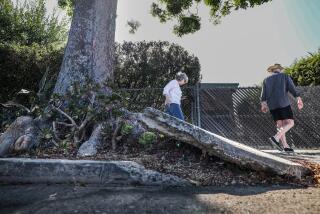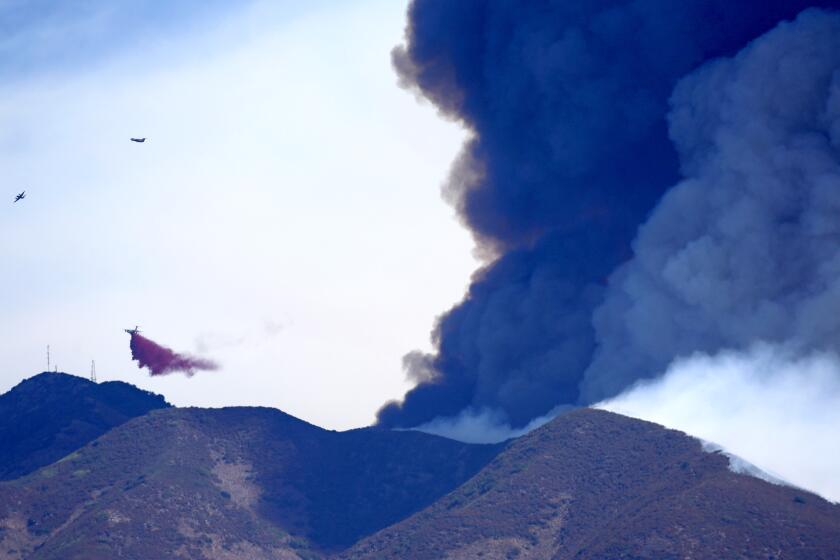Wilshire’s bad for cyclists? It doesn’t get much better elsewhere.
Wilshire Boulevard on the Westside: I wouldn’t want to ride my bike there.
Then again, I don’t have to. A lot of cyclists don’t have that choice, though.
According to California law, bicyclists have all the rights and responsibilities of motor vehicle operators, including the right to ride on every public roadway where cars are allowed. The only exception is some limited-access freeways through areas where there are alternative routes that cyclists can use.
ABOUT BLOWBACK: FAQs and submission policy
That includes dangerously congested streets like Wilshire Boulevard in the Brentwood-Westwood corridor on either side of, and under, the 405 Freeway. As Times editorial writer Carla Hall noted, this stretch is particularly harrowing for bike riders.
Bicyclists bold enough to brave it -- or more often, those with no other viable choice -- find an unforgiving street structured for maximum automotive throughput; in other words, one of the city’s busiest roadways, built to funnel through as many cars, trucks and SUVs as possible, with no regard for the human beings who live, work, walk or ride nearby.
It’s an area so clogged with traffic that it barely moves much of the day; the city often stations officers to direct traffic flow so backed-up motorists don’t block key intersections and turn the entire road network into a snarled, gridlocked mess.
FULL COVERAGE: Sharing the road in L.A.
Or more of one than it already is.
It’s about as uninviting an environment for bike riders and pedestrians as anyone could design, intentionally or otherwise. As someone who frequently passes through the area, I do my best to avoid it, whether traveling by foot, bike or car.
Unfortunately, many people who live or work in the area aren’t so lucky -- like those who live in the densely stacked condos and apartments in Brentwood, or employees and students who commute to jobs in Westwood or classes at UCLA, for instance.
In order to avoid Wilshire, they have to bike through the Veteran Administration grounds, then south to Ohio Avenue, and several blocks back up to Wilshire or UCLA on narrow, high-traffic streets, adding needless miles and stress to their trips. A long-abandoned off-road bikeway through Veteran Park and along Sepulveda Boulevard that could ease some of that journey lies in such disrepair that it’s virtually unrideable.
Or cyclists can ride through the VA campus to Sepulveda, taking their chances with high-speed northbound traffic, then ride up a steep hill on Montana Avenue before coasting down to Westwood -- and with even more, steeper hills on the way back.
Those hills and extra miles may not seem like much behind the wheel of a car with a few hundred horses under the hood. But when the only power comes from your own legs, every added climb and detour along the way adds up.
It wasn’t always like this.
Before the Sept. 11 terrorist attacks, bicyclists were allowed to ride through the Los Angeles National Cemetery, providing a direct route from UCLA to Brentwood while virtually avoiding automotive traffic. Unfortunately, that route was shut down in the national security panic that followed and hasn’t been reopened since, despite the minimal risk bike riders pose to anyone, let alone those already dead.
Like it or not, that means bikes and motor vehicles must share busy Wilshire, even though it was designed for the latter with no thought to the safety of the former.
On the other hand, that’s really not a problem.
Or, at least, it shouldn’t be.
At rush hour, bikes can often travel as fast, or faster, than the clogged traffic around them; other times of day, drivers can simply change lanes to go around them. All it takes is a little patience and enough human compassion to recognize that it’s not just a cyclist on that bike, it’s someone’s mother or father, daughter or son just trying to get back home to their loved ones in one piece.
Things may get better soon. The city recently painted a short, two-block bike lane on Wilshire through “condo canyon” west of Beverly Hills; hopefully, that two-block stretch will grow into a viable alternative for bicyclists traveling to and from points east.
Meanwhile, Wilshire is scheduled to get a bus rapid transit lane along most of its length by November 2014. Those lanes will be restricted to bus use during the morning and evening rush hours -- with the exception of bicycles, which will be allowed to share the lanes with buses.
That is, at least for those riders with the courage to hold their own against a bus rushing up from behind.
Long term, the solution for Wilshire and every other street in Los Angeles is not to ban bikes or to turn more surface streets into high-speed virtual freeways. Rather, the solution is to build roads that accommodate all users safely and comfortably, with a focus on moving people rather than cars.
ALSO:
McManus: Poof goes the middle class
Leave the Nevada school shooter’s parents alone
A propofol-free colonoscopy? Some doctors say yes.
Ted Rogers is the author of the blog BikinginLA.com. He is also a board member of the Los Angeles County Bicycle Coalition.
This post is part of an ongoing conversation to explore how the city’s cyclists, drivers and pedestrians share and compete for road space, and to consider policy choices that keep people safe and traffic flowing. For more: latimes.com/roadshare and #roadshareLA.
More to Read
A cure for the common opinion
Get thought-provoking perspectives with our weekly newsletter.
You may occasionally receive promotional content from the Los Angeles Times.










